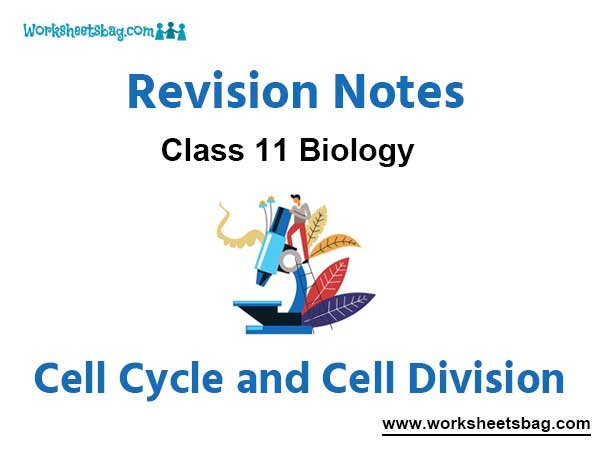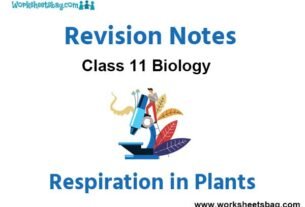Please refer to the Cell Cycle and Cell Division Notes Class 11 Biology given below. These revision notes have been designed as per the latest NCERT, CBSE, and KVS books issued for the current academic year. Students will be able to understand the entire chapter in your class 11th Biology book. We have provided chapter-wise Notes for Class 11 Biology as per the latest examination pattern.
Revision Notes Chapter 10 Cell Cycle and Cell Division Class 11 Biology
Students of Class 11 Biology will be able to revise the entire chapter and also learn all important concepts based on the topic-wise notes given below. Our best teachers for Grade 11 have prepared these to help you get better marks in upcoming examinations. These revision notes cover all important topics given in this chapter.
♦ The growth and reproduction of all organisms depend on the division and enlargement of cells.
♦ The mechanisms of division and multiplication of cells together constitute cell reproduction.
CELL CYCLE
♦ It is the life period of a cell during which a cell synthesizes DNA (replication), grows & divides into 2 daughter cells.
♦ Cell growth (cytoplasmic increase) is a continuous process but DNA synthesis occurs only at a specific stage.
♦ Duration of cell cycle varies in each organism and each cell type. E.g. Duration of a typical eukaryotic cell cycle (e.g. human cell) is about 24 hrs. In Yeasts, it is 90 minutes
Phases of Cell Cycle
Cell cycle includes 2 basic phases: Interphase & M Phase.

1. Interphase (resting phase)
♦ It is the phase between two successive M phases.
♦ It includes cell growth and DNA synthesis.
♦ It lasts more than 95% of the duration of cell cycle.
Interphase has 3 phases:
a. G1 phase (Gap 1 or Antephase): First growth phase. It is the interval between mitosis and DNA replication.
Main events:
♦ Continuous growth of cell.
♦ Cell becomes metabolically active.
♦ Prepares machinery for the DNA replication.
♦ Synthesizes RNA and proteins.
b. S (Synthetic) phase:
♦ In this, DNA replication takes place.
♦ Amount of DNA per cell doubles. But chromosome number is not increased.
♦ In animal cells, replication begins in the nucleus, and the centriole duplicates in the cytoplasm.
c. G2 phase (Gap 2):
♦ Second growth phase. Cell growth continues.
♦ Synthesis of RNA and proteins continues.
♦ Cell is prepared for mitosis.
2. M Phase (Mitosis phase)
♦ It represents the actual cell division (mitosis).
♦ In human cell cycle, it lasts for only about an hour.
♦ M Phase includes karyokinesis (nuclear division) and cytokinesis (division of cytoplasm).
♦ Some cells do not show division. E.g. heart cells.
♦ Many other cells divide only occasionally to replace damaged or dead cells.
♦ The cells that do not divide further exit G1 phase and enter an inactive stage called quiescent stage (G0). Such cells remain metabolically active but do not proliferate.
MITOSIS
♦ It is the cell division occurring in somatic cells.
♦ It is also called as equational division as the number of chromosomes in the parent and progeny cells is same.
♦ Mitosis is generally seen in diploid cells. It also occurs in haploid cells of some lower plants and some social insects.
♦ It involves major reorganization of all cell components.
The karyokinesis of mitosis has 4 stages: Prophase, Metaphase, Anaphase & Telophase.
1. Prophase
♦ It is the longest phase in mitosis.
♦ It follows the S and G2 phases of interphase.
♦ In the S & G2 phases, DNA molecules are intertwined.
♦ Characteristic events:
a. Chromosomal materials (chromatin fibres) are untangled and condensed to form mitotic chromosomes. They are seen to be composed of two chromatids attached together at the centromere.
b. Centrosomes begin to move towards opposite poles of the cell. Each centrosome radiates out microtubules called asters. The two asters together with spindle fibres forms mitotic apparatus.
♦ Cells at the end of prophase do not show Golgi complexes, endoplasmic reticulum, nucleolus & nuclear envelope.
2. Metaphase
♦ The nuclear envelope completely disintegrates. Hence the chromosomes spread through the cytoplasm of the cell.
♦ Chromosome condensation is completed. They can be observed and studied easily under the microscope. They will have two sister chromatids.
♦ Chromosomes come to lie at the equator. The plane of alignment of the chromosomes at metaphase is called the metaphase plate.
♦ The spindle fibres from both poles are connected to chromatids by their kinetochores in the centromere.
3. Anaphase
♦ It is the shortest phase in the mitosis.
♦ Centromere of each chromosome divides longitudinally resulting in the formation of two daughter chromatids (chromosomes of the future daughter nuclei).
♦ As the spindle fibres contract, the chromatids move from the equator to the opposite poles.
4. Telophase
♦ Chromosomes cluster at opposite poles and uncoil into chromatin fibres.
♦ Nuclear envelope develops around the chromosomeclusters at each pole. Thus 2 daughter nuclei are formed.
♦ Nucleolus, Golgi complex and ER reappear.
♦ The spindle fibres disappear.
Cytokinesis
♦ It is the division of cytoplasm to form 2 daughter cells. It starts when telophase is in progress.

♦ Cytokinesis in animal cell: Here, a cleavage furrow is appeared in the plasma membrane. It gradually deepens and joins in the centre dividing the cytoplasm into two.
♦ Cytokinesis in plant cell: It is different from the cytokinesis in animal cells due to the presence of cell wall. In plant cells, the vesicles formed from Golgi bodies accumulate at the equator. It grows outward and meets the lateral walls. They fuse together to form the cell-plate. It separates the 2 daughter cells. Later, the cell plate becomes the middle lamella.
♦ During cytokinesis, organelles like mitochondria and plastids get distributed between the daughter cells.
♦ In some organisms karyokinesis is not followed by cytokinesis. As a result, multinucleate condition (syncytium) arises. E.g. liquid endosperm in coconut.
Significance of Mitosis
♦ It produces diploid daughter cells with identical genome.
♦ It helps to retain the same chromosome number in all somatic cells.
♦ It helps in the body growth of multicellular organisms. Mitosis in the meristematic tissues helps in a continuous growth of plants throughout the life.
♦ It restores the nucleo-cytoplasmic ratio that disturbed due to cell growth.
♦ It helps in cell repair & replacement. E.g. cells of the upper layer of the epidermis, lining of the gut & blood cells.
MEIOSIS
♦ It is the division of diploid germ cells that reduces the chromosome number by half forming haploid daughter cells (gametes). It occurs during gametogenesis.
♦ It leads to the haploid phase in the life cycle of sexually reproducing organisms. Fertilisation restores diploid phase.
Key features of meiosis
♦ It involves two cycles (meiosis I & meiosis II) but only a single cycle of DNA replication.
♦ It involves pairing of homologous chromosomes and recombination between their non-sister chromatids.
♦ Meiosis I begins after replication of parental chromosomes to form identical sister chromatids at the S phase.
♦ 4 haploid cells are formed at the end of meiosis II.

Meiosis I
Prophase I:
♦ It is typically longer and more complex
♦ It includes 5 phases based on chromosomal behaviour:
Leptotene, Zygotene, Pachytene, Diplotene & Diakinesis.
Leptotene (Leptonema): Chromatin fibres become long slender chromosomes. Nucleus enlarges.
Zygotene (Zygonema): Chromosomes become more condensed. Similar chromosomes start pairing together (synapsis) with the help of a complex structure called synaptonemal complex. The paired chromosomes are called homologous chromosomes. Each pair of homologous chromosomes is called a bivalent.
Pachytene (Pachynema): Comparatively longer phase. Bivalent chromosomes split into similar chromatids. This stage is called tetrads. During this, recombination nodules appear at which crossing over occurs. It leads to genetic recombination on homologous chromosomes. Recombination is completed by the end of pachytene.
Diplotene (Diplonema): Dissolution of the synaptonemal complex occurs. The recombined homologous chromosomes of the bivalents separate from each other except at the sites of crossovers. These X-shaped structures are called chiasmata. In oocytes of some vertebrates, diplotene lasts for months or years.
Diakinesis: Terminalisation of chiasmata. Chromosomes are fully condensed. The meiotic spindle fibres originate from the poles to prepare the homologous chromosomes for separation. Nucleolus & nuclear envelope disappear.
Metaphase I:
Spindle formation is completed. The chromosomes align on the equatorial plate. The microtubules from the spindle attach to the pair of homologous chromosomes.
Anaphase I:
The homologous chromosomes separate, while sister chromatids remain associated at their centromeres.
Telophase I:
♦ The nuclear membrane and nucleolus reappear and 2 haploid daughter nuclei are formed. This is called diad.
♦ After this, cytokinesis may or may not occur.
♦ After a short interphase, it is followed by meiosis II.
♦ This short stage between the two meiotic divisions is called interkinesis. DNA replication does not occur in this phase.

Meiosis II
It resembles the mitosis. It has the following phases:
Prophase II:
It is initiated immediately after cytokinesis. The chromosomes again become compact.
Nucleolus and nuclear membrane disappear in both nuclei.
Metaphase II:
The chromosomes align at the equator and the microtubules from opposite poles of the spindle get attached to the kinetochores of sister chromatids.
Anaphase II:
It begins with the simultaneous splitting of the centromere of each chromosome (which was holding sister chromatids together). Thus they move toward opposite poles of the cell
by shortening of microtubules attached to kinetochores.
Telophase II:
The two groups of chromosomes once again get enclosed by a nuclear envelope; cytokinesis follows resulting in the formation of tetrad of cells i.e., 4 haploid daughter cells.
Significance of meiosis
♦ It conserves the chromosome number of each species.
♦ It causes genetic variation (due to crossing over) in the population of organisms. It is important for evolution.


